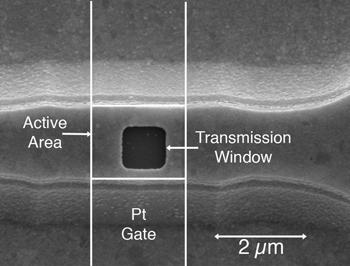Summary
Single photons are the fundamental particles for all optical measurements. Single photon detectors made from avalanche photodiodes or photomultiplier tubes are commercially available for applications such as time-correlated single photon counting and lidar. Quantum optical measurements that rely on single photons or more advanced quantum states of light such as entangled photon pairs are in their infancy now, but these bleeding-edge measurements are expected to lead to important new measurement methodologies in the next decade. Our project, in collaboration with the Quantum Information and Terahertz Technology Project, is developing sources and detectors for quantum states of light, one important device being a true photon counter, also known as a photon number-resolving detector. Such a device can measure the exact number of incident photons in a pulse of light. This is a critical enabler for quantum optical metrology.
Description

This project develops semiconductor nanostructures, especially self-assembled quantum dots and photonic crystals, for a variety of applications including single photonics, laser diodes, and quantum optical metrology. It also develops quantum optical metrology based on other sources and detectors (not based on semiconductor nanostructures). It collaborates extensively with the Quantum Information and Terahertz Technology Project and with JILA to accomplish some of its goals.
Semiconductor quantum dot sources of single photons and entangled photon pairs offer many advantages compared to competing quantum emitter sources. The quantum dots can be tailored to emit at specific wavelengths. The spontaneous emission lifetime is ~ 1 ns, which leads to very high rates of single photon emission. Perhaps the biggest advantage of these sources is that they are easily integrated with high-Q cavities, enabling even faster emission and directional output. High-speed and high-efficiency single photon sources are an important enabler of quantum communications and the traceability of optical power to the photon.
Quantum-dot-based detectors of single photons exhibit linear gain at ultralow photon fluxes, which enables them to count the number of photons in a pulse of light. The photon number-resolving capability of the detector developed by the Nanostructure Fabrication and Metrology Project is unique in compound-semiconductor-based devices.
Quantum dot lasers were initially investigated because they were expected to have low threshold currents, high differential gain and modulation bandwidths, and be temperature-insensitive. Although not all of these predictions have been realized, quantum dot lasers have demonstrated some previously unpredicted and unusual behavior. Our project, in collaboration with JILA, has recently demonstrated wavelength bistability in a two-section monolithic quantum dot laser and also a "dark pulse" laser, a novel pulsed laser in which the pulses have lower intensity than the DC level.
Major Accomplishments
- Developed a photon-number resolving detector based on quantum dots (Quantum Dot Optically Gated Field Effect Transistor, QDOGFET)
- Demonstrated a type of mode-locked laser that produces "dark pulses"
- Demonstrated a bistable, switchable quantum dot laser
- Developed spectral-hole-burning technique to demonstrate that exciton coherence time in a quantum dot is limited only by the spontaneous emission lifetime
- Measured g(3) and g(4), the third- and fourth-order intensity correlation, from a pseudothermal source of light

